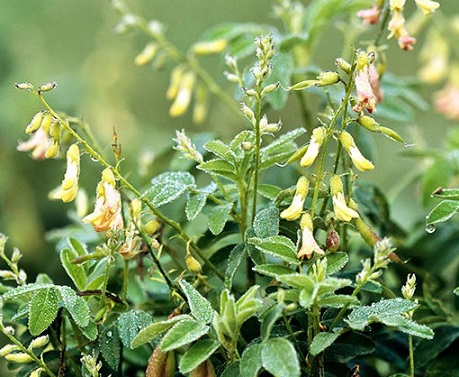Herbs And Phytochemicals: Jaranol From Cloves, Licorice Or Astragalus Can Be Used As An Adjuvant To Treat COVID-19 And Even Lung Adenocarcinoma!
Nikhil Prasad Fact checked by:Thailand Medical News Team Jan 25, 2024 1 year, 11 months, 2 weeks, 4 days, 1 hour, 28 minutes ago
Herbs And Phytochemicals: The relentless spread of COVID-19, caused by the SARS-CoV-2 virus, has plunged the world into an unprecedented global health crisis. Among the myriad challenges faced by healthcare systems, patients with pre-existing conditions, particularly lung adenocarcinoma (LUAD), stand out as a vulnerable population susceptible to severe outcomes when infected with COVID-19. While various treatment strategies have been employed to address the complexities of COVID-19, there remains a critical gap in effectively managing the unique challenges faced by those with coexisting LUAD. This
Herbs And Phytochemicals news report delves into the promising properties of jaranol, a naturally derived flavonoid found in cloves, licorice, and Astragalus membranaceus, exploring its potential as an adjuvant therapy for COVID-19 in LUAD patients.

Astragalus - A Source Of Jaranol
Jaranol: A Natural Flavonoid with Multifaceted Potential
Jaranol, also known as kumatakenin, emerges as a beacon of hope in the realm of natural compounds with potential therapeutic benefits against both viral infections and cancer. This flavonoid, abundant in various herbs including cloves, licorice, and Astragalus membranaceus, has demonstrated inhibitory activity against liver, endometrial, and ovarian cancers in previous studies. Beyond its anticancer properties, jaranol has exhibited efficacy in inhibiting the replication and transmission of the influenza virus. Recent research has unveiled its potential as an antiviral agent against SARS-CoV-2 in human lung adenocarcinoma cells. However, the intricate mechanisms by which jaranol addresses the challenges posed by the coexistence of COVID-19 and LUAD remain largely unexplored.
Investigating Jaranol's Molecular Targets and Mechanisms
A groundbreaking study conducted by the College of Life Science at Yangtze University-China utilized network pharmacology to unravel the molecular intricacies of jaranol's therapeutic potential against COVID-19 and LUAD. The research identified 47 common target genes for jaranol, forming the foundation for further exploration. Building on this, an eight-gene risk score model was meticulously constructed, demonstrating robust predictive accuracy specifically tailored for LUAD patients.
Functional enrichment analysis unveiled the key biological processes influenced by jaranol, with a particular focus on the regulation of the response to hormones, positive regulation of phosphorylation, and involvement in the PI3K-Akt signaling pathway. This multifaceted approach indicates that jaranol might be instrumental in modulating not only viral infections but also intricate cellular signaling pathways implicated in cancer progression.
Molecular docking analysis further enriched our understanding of jaranol's interactions at the molecular level. The study revealed a significant affinity between jaranol and eight hub targets (AKT1, SRC, EGFR, HSP90AA1, ESR1, PTGS2, PPARG, and MMP9), pivotal players in cellular processes linked to both viral infections and cancer progression. Additionally, jaranol exhibited a remarkable binding capacity with three core COVID-19-related targets (ACE2, 3CLpro, and PLpro), e
mphasizing its potential dual efficacy against COVID-19 and LUAD.
Validation and Clinical Implications
To validate the direct binding between jaranol and MMP9, a central hub gene identified in the study, cellular thermal shift assay (CETSA) experiments were conducted in A549 lung cancer cells. The results unequivocally confirmed the ability of jaranol to directly bind to MMP9, emphasizing its potential as a targeted therapeutic agent in both COVID-19 and LUAD.
A clinical prognostic analysis, employing a risk score model comprising eight genes (CDK1, ABCC1, IL2, F2, HSP90AA1, KIT, PIK3CG, and PPARG), demonstrated the model's reliability in predicting outcomes for LUAD patients. High-risk patients, as determined by the risk score, exhibited significantly higher mortality rates and shorter overall survival, underscoring the potential clinical relevance of jaranol in improving outcomes for this patient population.
Mechanistic Insights and Potential Therapeutic Benefits
Functional enrichment analysis and the construction of a protein-protein interaction (PPI) network shed light on the involvement of the PI3K-Akt signaling pathway and eight hub genes in jaranol's mechanism of action. These genes play pivotal roles in regulating inflammation, immune response, and tumor progression, making them attractive therapeutic targets for the dual challenges of COVID-19 and LUAD.
The KEGG enrichment analysis highlighted the concentration of the 47 intersection genes in the PI3K-Akt signaling pathway. This pathway, known for its involvement in endocytosis of SARS-CoV-2 and its association with non-small cell lung cancer (NSCLC), presents a plausible avenue through which jaranol may exert its therapeutic effects.
Moreover, molecular docking analysis revealed the high binding capacity of jaranol with its target proteins, affirming its potential as a versatile treatment option. Jaranol's favorable binding affinities with COVID-19-related targets further position it as a promising candidate for simultaneous intervention against both COVID-19 and LUAD.
Conclusion
In conclusion, this comprehensive study unveils the potential of jaranol as an adjuvant therapy for COVID-19 in LUAD patients. Through network pharmacology, molecular docking, and CETSA experiments, the research not only identified molecular targets but also validated the binding capacities and provided mechanistic insights into jaranol's therapeutic effects. By targeting key hub genes and pivotal pathways, jaranol emerges as a potential dual-purpose agent capable of addressing the complexities of COVID-19 and LUAD simultaneously.
The findings of this study not only broaden the therapeutic options for COVID-19 and LUAD but also offer novel perspectives for the development of jaranol as a promising pharmaceutical candidate. As we navigate the challenges posed by the interplay between viral infections and cancer, jaranol stands at the forefront as a beacon of hope, beckoning further in vitro, in vivo, and clinical investigations to fully harness its therapeutic potential. The journey towards a comprehensive understanding of jaranol's role in combating COVID-19 and LUAD is an exciting frontier in the quest for effective and tailored therapeutic interventions.
The study findings were published in the peer reviewed Arabian Journal of Chemistry.
https://www.sciencedirect.com/science/article/pii/S1878535224000509
For the latest on
Herbs And Phytochemicals, keep on logging to Thailand Medical News.
